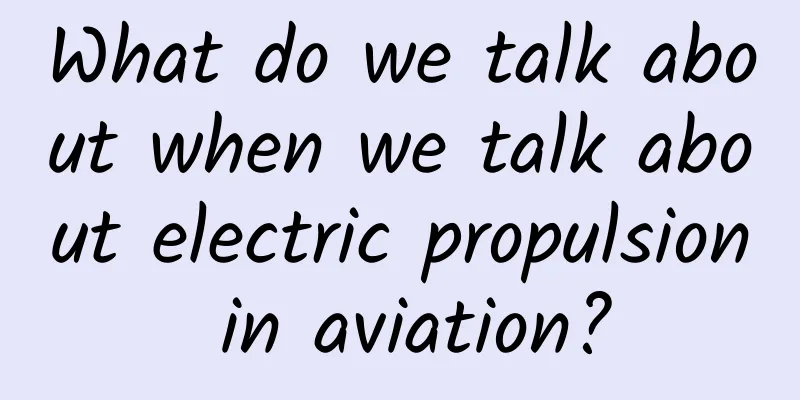What do we talk about when we talk about electric propulsion in aviation?

|
Let’s talk about what is aviation electric propulsion? Simply put, aviation electric propulsion technology converts electrical energy into kinetic energy to drive the aircraft to move. It uses a fuel-driven aviation gas turbine generator in conjunction with a battery pack to generate or store electrical energy, and converts electrical energy into shaft power through different coupling methods between the turbine and the motor, thereby driving a fan or distributed fan to generate the power required by the aircraft. Let’s talk about why we need to develop aviation electric propulsion technology? Electric propulsion technology has the potential to make our journeys cleaner, cheaper and more comfortable. The aviation industry has always been a major carbon emitter in the global industry. According to data from EDGAR (Emissions Database for Global Atmospheric Research), in 2020, the amount of carbon dioxide emitted by the international aviation industry from the combustion of fossil fuels accounted for about 1% of the global total emissions. Aviation electric propulsion technology can emit less or even no carbon dioxide by adopting clean energy such as hydrogen, wind, and light energy, thereby effectively reducing the impact on the environment. It is one of the main power solutions for the aviation industry to achieve the goal of net zero emissions. In addition, since the cost of obtaining electricity can be very low or even zero cost, and the electric propulsion system is relatively easy to maintain, flying becomes more economical. Finally, in the process of converting electrical energy into kinetic energy, less noise is generated, which greatly improves the comfort of the journey. Given so many benefits, why haven't we seen electric-propulsion aircraft in our daily lives? Electric aircraft built with current technology are simply too heavy, and require extra weight and energy to cool the working parts, making them very inefficient. All aspects of the field of electric propulsion in aviation, including technologies such as motors, converters, circuit breakers, batteries, and cooling systems, still face some major challenges waiting to be overcome to keep components cool and minimize weight and heat losses. Let’s talk about what achievements have been made in aviation electric propulsion technology so far? In February 2024, Fengfei Aviation Technology Company used the pure electric 5-seater eVTOL aircraft Shengshilong to complete the flight from Shenzhen Shekou Cruise Home Port to Zhuhai Jiuzhou Port Terminal, shortening the one-way 2.5 to 3 hours of ground driving to 20 minutes. The aircraft is 11.6 meters long, with a wingspan of 14.5 meters, equipped with 13 propellers, a maximum take-off weight of 2,000 kg, a maximum payload of 350 kg, a maximum range of 250 kilometers, a maximum cruising speed of 200 kilometers per hour, and a passenger capacity of 4 seats + 1 pilot. This is the world's first public demonstration flight of a cross-sea and cross-city eVTOL electric vertical take-off and landing aircraft route, with a round-trip journey of more than 100 kilometers. In March 2024, the full-scale prototype of Airbus's all-electric 4-seater eVTOL CityAirbus NextGen debuted at the Citybus test center in Donauwörth, Germany. It uses eight electric propellers as a distributed propulsion system, weighs 2 tons, has a wingspan of 12 meters, a speed of 120 kilometers per hour, and a range of 80 kilometers. In addition, UAV engine manufacturer UAVHE released the 48kW hybrid electric propulsion system RW1-300C, Kite launched the 120kW KM-120 aviation electric motor, and UEC United Engine Manufacturing Group displayed a 500kW hybrid electric propulsion device verification machine at the 2023 Russian Industrial Exhibition. NASA, GE, Safran and many other scientific research institutions and international companies have also carried out a lot of research and experimental work in various key technical fields of aviation electric propulsion. Although, due to the demanding power requirements of aviation flight, aviation electric propulsion technology still faces many challenges to overcome. However, the current research results have begun to show their edge and show great development potential. With the continuous deepening of technical research, practical aviation electric propulsion technology will become more and more mature, bringing revolutionary changes to our flight journey. |
<<: Can gray hair turn black again? The doctor's answer is unexpected
>>: Over the years, which "antidotes" in movies and TV shows have fooled you?
Recommend
3 formulas for B station to become popular with over 1 million views!
A cool designer, a low-key female writer, and a r...
Why does rhinitis get worse in winter in the north?
Speaking of rhinitis, it is estimated that many p...
Human weaknesses = marketing hot spots! 3500 words to expose human nature and teach you how to cover the sky with one hand
As the saying goes, man proposes, God disposes, b...
2020 Tour Guide Certificate Examination Time Confirmed Tour Guide Qualification Certificate Registration Time Entry Query
The General Office of the Ministry of Culture and...
13 lessons to cultivate a beautiful back and swan neck, easily appear 5 cm taller, and shape a perfect body curve
13 lessons to cultivate a beautiful back and swan...
If I accidentally eat the "oil" from a gel pen, is it okay?
Review expert: Gan Qiang, lecturer at Beijing Ins...
How much does it cost to invest in the Hailar Furniture Mini Program?
How much does it cost to attract investors for th...
Senior NeXT/Apple developer praises Swift 1.2
Wil Shipley is a senior developer who worked at N...
How much does it cost to buy a WeChat mini program in the same city? How much does it cost to create a WeChat mini program?
How much does it cost to buy a WeChat mini progra...
Who uses social apps more frequently to read news? Middle-aged people outnumber young people
How many times does a WeChat user check Moments o...
User Operation Awakening and Recall Methodology
Let us use strategic operations to "recall u...
What time does the 2022 Winter Olympics Commendation Ceremony start? Where can I watch the Winter Olympics Commendation Ceremony live? Live broadcast address is attached!
The 2022 Winter Olympics and Paralympics have come...
Will young people develop age spots if they stay up late? Young people do develop age spots, but the reason is...
Rumor: "Young people who stay up late will d...
Analyst: 2016 will be a make-or-break year for Apple
CNBC reported on the early morning of the 30th Be...
World Osteoporosis Day丨“Brittle bones” are not just a problem for the elderly. How to prevent and treat osteoporosis?
Did you break your bones just by moving a flower ...









